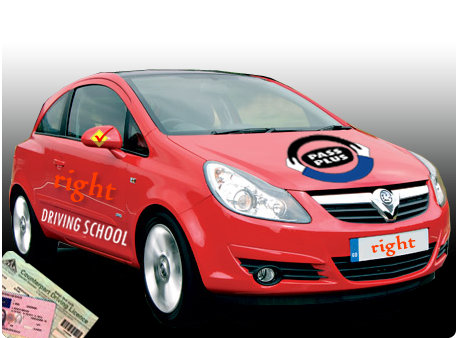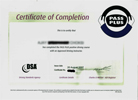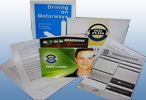Pass Plus Course
At the start of your course, your driving instructor will give you a copy of the Pass Plus pupils guide. Then it will take at least 6 hours, though it can take longer if we think it’s necessary. Pass Plus is a practical course & all modules should be practical sessions. However, local conditions & time of year may mean that some modules need to be given as a theory session. A theory session could be given if there is no motorway nearby. We will complete a training report form. To pass the Pass Plus course you’ll need to reach a satisfactory standard in all 6 course modules. Once passed all 6 modules your Pass Plus certificate will be sent to you.
Pass Plus consists of six modules about driving in different conditions:
- Driving around a town, - All weather driving, - Driving in the country side, – Driving at night, - Driving on dual carriage ways, - Driving on Motorways
modules #1

DRIVING AROUND A TOWN
The first module has two parts. It begins with an introduction to Pass Plus, explaining the course aims and the skills and knowledge to be covered.
The second part is a practical session covering the different features of driving in a town, such as complex junctions and public transport.
You'll focus on:
- - Observation, judgment and awareness
- - Eye contact
- - Consideration for vulnerable road users
- - Showing caution
- - Keeping space around your car
modules #2

ALL WEATHER DRIVING
This module will be covered as much as possible in a practical session. You'll focus on correct speed, safe stopping distances, plus seeing and being seen in:
The second part is a practical session covering the different features of driving in a town, such as complex junctions and public transport.
You'll focus on:
- - Rain
- - Sleet, snow and ice
- - Mist and fog
- - Bright sunshine
- - You’ll also look at skidding, and:
- - What causes skids
- - How to prevent skids
- - Correcting slow-speed skids
- - Braking on poor surfaces
- - Aquaplaning
modules #2

DRIVING IN COUNTRYSIDE
This module looks at the main differences between town and country driving:
The second part is a practical session covering the different features of driving in a town, such as complex junctions and public transport.
You'll focus on:
- - Observing the road ahead
- - Making progress safely
- - Bends, hills, uneven roads and dead ground
- - Keeping a safe distance from the vehicle ahead
- - Safe overtaking
It focuses especially on being aware and showing consideration for:
- - Pedestrians, horse riders and animals in the road
- - Farm entrances
- - Slow moving vehicles
- - Aquaplaning

What is Pass Plus course?
Pass Plus is a DSA approved training course aimed at the 17 – 30 years. Designed to be taken after passing your L-Test. You will learn how to deal with various challenges that you may not have encountered during your pre-test lessons. Thereby helping you to be a safer, more confident driver.
Why Pass Plus?
 Newly qualified drivers are much more vulnerable than they realise. Statistics show that new drivers are more likely to have an accident within the first two years after passing their driving test, than at any other time in their driving career. A quarter of those killed on the roads are under 21 years old. 95% of RTA’s are caused by human error, and the new driver’s comparative lack of experience often leads to these errors.
Newly qualified drivers are much more vulnerable than they realise. Statistics show that new drivers are more likely to have an accident within the first two years after passing their driving test, than at any other time in their driving career. A quarter of those killed on the roads are under 21 years old. 95% of RTA’s are caused by human error, and the new driver’s comparative lack of experience often leads to these errors.
Who can take Pass Plus?
Anyone with a Full UK License can take Pass Plus. However, it is primarily aimed at the 17 to 25 age group, and is intended to be taken within the first year of passing their L-Test. You will not have to take a test at the end of the course but you will be continually assessed. You must successfully complete all the modules in the course to an achieved or exceeded standard.
However, it is primarily aimed at the 17 to 25 age group, and is intended to be taken within the first year of passing their L-Test. You will not have to take a test at the end of the course but you will be continually assessed. You must successfully complete all the modules in the course to an achieved or exceeded standard.
Pass plus course designed to be taken as 6 1hr lessons. However, this can be into two, three or four sessions. It offers professional instruction in the above areas helping them to:
- Gain quality driving experience (Safely)
- Become a more skillful driver
- Develop a positive driving style to make driving enjoyable, but safe.
- Reduce their risk of being involved in an accident.
What are the benefits?
In addition to their broader range of skills, greater confidence and reduced accident risk, all major insurance companies will offer a substantial discount on the cost of their insurance policies. This is usually in the area of 30% (similar to having a no-claims bonus, but in their first year of driving!) For example that is £100 off a £500 premium. Many pupils benefit even more.
How much does Pass Plus cost?
Our fee for taking Pass Plus is £150 wever, in light of the importance and success of the Pass Plus course several local authorities are helping pupils with the cost of the course.
Some boroughs, town, city or county councils offer discounts up to 30% full tuition costs. You’ve nothing to lose! So should this be of interest, then I will give full details of schemes in your area on application.
modules #4

DRIVING AT NIGHT
This covers the important parts of driving at night, dawn and dusk. You’ll learn about:
- - The importance of using headlights correctly
- - Adjusting to the dark
- - Judging speed and distance
- - The correct use of lights and keeping them clean
- - Dealing with dazzle
- - Hard-to-see road users
- - Parking issues
modules #5

DRIVING AT NIGHT
Dual carriageways are high speed roads where the two carriageways are separated by a central reservation.
You will need to have particular skills, including:
- - Effective observation, using your mirrors and checking blind spots
- - Judgement and planning ahead
- - Separation distances
- - Joining and leaving a dual carriageway
- - Overtaking and lane discipline
- - The correct use of speed
modules #6

DRIVING ON MOTORWAYS
This should be a practical session if possible. If there is no motorway nearby, it will be covered in a theory session.You should drive on a motorway as soon as you can afterwards so you can put the theory into practice.
The topics covered include:
- - Journey planning
- - Joining and leaving a motorway, and using slip roads
- - Safe speeds in different circumstances
- - Effective observation
- - Signs, signals and markings
- - Overtaking and lane discipline
- - Courtesy to other road users
- - Motorway fatigue
- - Breakdown procedures
- - Use of lights, including hazard warning lights
- - Debris on the carriageway
- - Crosswinds

